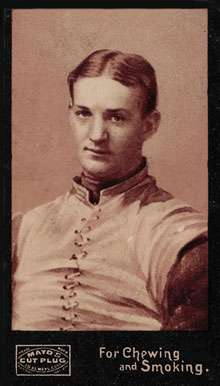Football card

A football card is a type of collectible trading card typically printed on paper stock or card stock that features one or more American football or Canadian football players or other related sports figures. These cards are most often found in the United States and Canada where the sport is popular.
Most football cards features National Football League players. There are also Canadian Football League and college football cards. Player cards normally list the player's statistics. Some special edition packs of cards include authentic autographs or jersey cards. Some may include bubble gum or a special edition player card. Many cards are now serial-numbered, meaning that there are only so many of that particular card produced. These include unique prints (numbered 1/1). Included in these are printing plates, used in the actual production of the card.
History
The first football cards were included in cigarette packages in the late 1800s.[1] In 1887 Yale football player Henry W. Beecher was included as the only football player in a set of 50 cards distributed in packs of Old Judge and Gypsy Queen cigarettes, being the first football card.[1] The first set of cards to focus on football players was printed by Mayo Cut Plug Tobacco Company in the early 1890s and featured players from the schools that became the Ivy League.[1]
In the early 1900s, trading cards were printed in mixed sport sets, and the football players were generally from college football.[1] They were used to promote other items in addition to tobacco products such as Spalding's sporting goods, breakfast cereal, ice cream, doughnuts and gum.[1]
Along with baseball cards, football cards began gaining popularity after World War II. In 1948, there were two sports card producers, Bowman Gum and Leaf Candy Company. Both produced their first football card sets, each consisting of about 100 cards of then-current players from the National Football League. Leaf only went on to produce one more set, a skip-numbered set in 1949. However, Bowman continued producing sets, from 1950 through 1955. Bowman was bought out by the Topps Chewing Gum Company in 1956.[1] That year, Topps produced its first regular football card set (after producing sets of historic college players in 1950, 1951, and 1955). Topps continued producing football cards until 2016.[2] Other popular companies are Upper Deck, Panini and Leaf.
Reception
In 2007, one of the earliest known football cards featuring John Dunlop from Harvard, was sold for $10,000, the highest price paid for a football card up to that time.[3]
In their humor book Football Uncyclopedia, Michael Kun and Adam Hoff compare football card collectors to baseball card collectors claiming among other things that "Baseball fans keep their old baseball cards in firm plastic sleeves...[and] include their baseball-card collections in their wills" while "Football fans could not give two craps about collecting football cards" which they present as "Exhibit A for why football fans are smarter than baseball fans."[4]
In January 2014, football cards from the collection of Jefferson R. Burdick, including ones dating to 1894, were displayed at the Metropolitan Museum of Art in New York City.[5]
"[6] In March 2016, veteran sports card dealer Brian Cataquet discovered 1970 Football cards produced by Topps with players wrong names printed on the back of the cards. These cards pictured the correct players photo and name on the front of the card, but on the back of the cards had a different players name printed by error. "There were five in the collection Cataquet acquired: Tommy Nobis front/ Chuck Walton printed on reverse Bill Brown front/ Steve Delong on reverse Rich Jackson front/Bart Starr reverse Roland Lakes front/ Dave Robinson reverse Len St. Jean front/ Dave Rowe reverse"
See also
References
- 1 2 3 4 5 6 Rielly, Edward J. (2009). Football: An Encyclopedia of Popular Culture. U of Nebraska Press. pp. 369–. ISBN 9780803226302. Retrieved 1 February 2014.
- ↑ "Company Overview of The Topps Company, Inc". Bloomberg Business Week. Retrieved February 2, 2014.
- ↑ (II.), Robert F. Lewis (2010). Smart Ball: Marketing the Myth and Managing the Reality of Major League Baseball. Univ. Press of Mississippi. pp. 44–. ISBN 9781604732177. Retrieved 1 February 2014.
- ↑ Kun, Michael; Hoff, Adam (2013-10-09). Football Uncyclopedia: A Highly Opinionated Myth-Busting Guide to America's Most Popular Game. Clerisy Press. pp. 41–. ISBN 9781578603114. Retrieved 1 February 2014.
- ↑ Anne Mancuso and Philip Richardson (January 31, 2014), "Spare Times - Metropolitan Museum of Art: 'Gridiron Greats: Vintage Football Cards in the Collection of Jefferson R. Burdick'", New York Times, p. C20, retrieved February 1, 2014
- ↑ "Wrong Backs". Sports Collectors Daily. 2016-03-27.